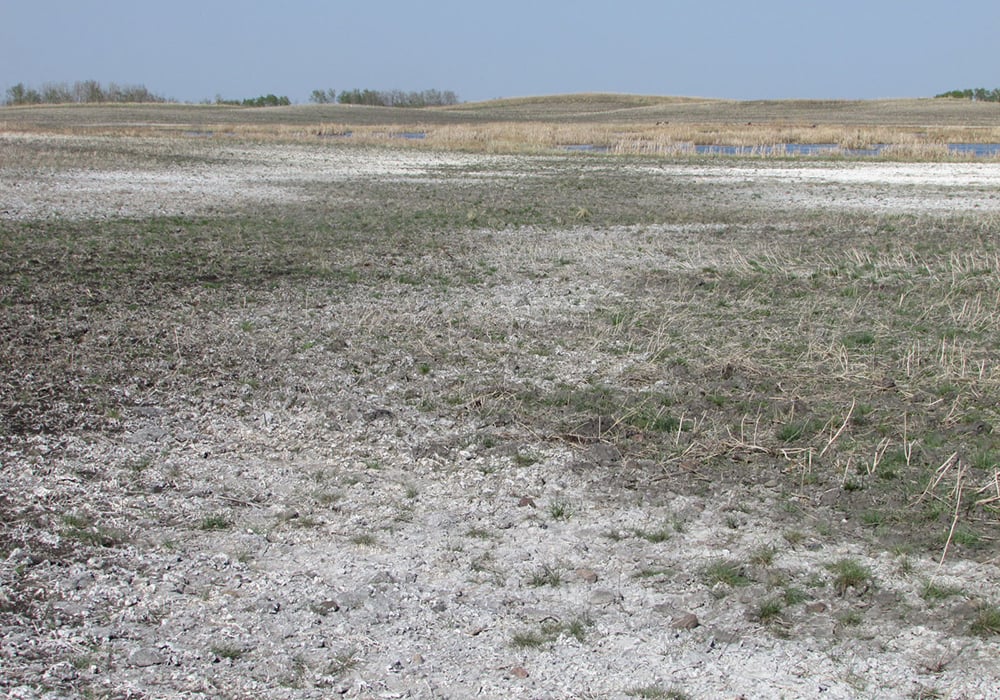The goal is to manage salt-affected soil more effectively, maximize production and potentially reclaim damaged acres
Salinity and insanity.
The two words sound the same.
And in some ways, our treatment of saline soils fits Albert Einstein’s famous definition of insanity — doing the same thing over and over again and expecting a different outcome.
Continuing to crop those saline patches the same way year after year and expecting a different outcome is an approach that clearly hasn’t been working well.
That’s one of the reasons why Blake Weiseth, applied research lead at Glacier FarmMedia’s Discovery Farm near Langham, Sask., decided to take a closer look at saline soils and how they can be managed differently.
Read Also

Farming Smarter receives financial boost from Alberta government for potato research
Farming Smarter near Lethbridge got a boost to its research equipment, thanks to the Alberta government’s increase in funding for research associations.
The goal of Discovery Farm’s salinization project is to manage salt-affected soils more effectively, to maximize production and potentially to reclaim salt-affected acres and return them to the annual crop rotation.
“Our salinity project is really in response to a problem that we see both across Canada and certainly here on our Discovery Farm, where we do have some salt-affected soils, to varying degrees of severity,” said Weiseth.
“We’ve identified about a two-acre site on our Discovery Farm property that’s especially impacted by salinity and what we want to do is take a targeted approach to that site, rather than continuing to annual crop it year after year and getting less than ideal performance.”
Weiseth shared details of the salinity project during Discovery Farm’s first annual field day on Aug. 19.
Together with project partners Ducks Unlimited, Nutrien Ag Solutions and Proven Seed, Discovery Farm is establishing three different salt-tolerant forage varieties on test plots affected by salinity.
Replicated trials have been sown to Halo alfalfa, AC Saltlander wheatgrass and a multi-species forage blend known as Saline Master.
The trials were sown in late May and are off to a decent start thanks to reasonably good rainfalls throughout June.
“Our intention is that this is going to be a multi-year project and over time, we’re going to be assessing parameters like what is our above-ground yield, and what are the economics associated with that?” Weiseth said.
“But also, over time, what we’re hoping to see is whether these forages actually do have any ability to impact soil health, so things like, what is their impact on organic matter in that surface zone and what is the salt profile ….,” he added.
“We’re not, of course, expecting to see anything in the first year, but maybe two, three, four or five years down the road, we’ll see some positive impact.”
Like most salt-affected lands, the Discovery Farm’s salinity plots have limited productive capacity when it comes to growing annual crops.
However, they do support a healthy weed population, dominated by salt-tolerant weed species such as kochia and foxtail barley.
Initially, chemical herbicides won’t be used to control weeds on the newly established forages. Instead, weeds will be mowed at different times during the growing season, before seed set, to retain vegetative ground cover and reduce evaporation.
“We want to maximize the ground cover on that site. So even if there are some weeds, that’s not necessarily a bad thing because they’re covering the ground, and they’re preventing evaporation losses of water which can further pull up salts in the soil profile.”
In the first year, trial sites were mowed at two different heights — two inches and six inches above ground. Future assessments will determine if one mowing height is preferable to the other in terms of contributing to forage stand establishment.
Over time, and after continuous mowing to reduce weed populations, the forages will eventually out-compete the weeds, at least in theory.
As the project continues, soil properties will be monitored and assessed to determine if the salinity-affected soils can be returned to annual crop production, or if they should remain in forages.
“Obviously, with salt-affected soils, it’s not an issue that’s here one year and gone the next,” Weiseth said.
“It’s a long-term issue and it needs a long-term approach. So maybe we’ll see, after we’ve had it into a salt-tolerant forage species for a number of years, that we’ve maybe driven down some of those salts in the soil profile and maybe we could go back and annual crop that land for a few years after you’ve got the salinity under control. Or maybe not. Maybe it will have to stay in forages continuously.”
The salinity project is one of several research projects taking place at Discovery Farm, located beside the Ag In Motion Farm Show site near Saskatoon.
It’s estimated there are more than 2.5 million acres of salt-affected agricultural land in Western Canada and another 20 million acres that are at moderate to high risk of developing salinity problems.
Inappropriate management in saline areas has a cost. Changes will be required to increase per-acre profitability on ground that usually underperforms.
“When it comes to land, it’s not like we’re creating more arable land over time,” Weiseth said.
“What we have is kind of what we’ve got, so we’re trying to maximize our productivity on every acre.”


















